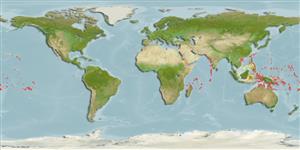>
Anguilliformes (Eels and morays) >
Muraenidae (Moray eels) > Uropterygiinae
Etymology: Uropterygius: Greek, oura = tail + Greek pterygion = little wing. Fin (Ref. 45335).
More on author: Regan.
Environment: milieu / climate zone / depth range / distribution range
पारिस्थितिकी
समुद्री प्रवाल-भित्ति संयुक्त; गहराई सीमा 1 - 18 m (Ref. 58302). Tropical; 30°N - 18°S
Indo-Pacific: Red Sea and East Africa to the Hawaiian and Society islands.
आकार / वज़न / Age
Maturity: Lm ? range ? - ? cm
Max length : 78.0 cm TL पुल्लिंग / अलिंग; (Ref. 90102)
जानवरों की रीड़ का जोड़: 130 - 136. Covered with large dark purplish-brown spots arranged in 2-3 irregular series on a reddish-tan background. Closely resembles Scuticaria tigrina which has dark spots of differing sizes.
Has been collected on reef flats (Ref. 37816). Benthic (Ref. 58302). Feeds on shrimps and fishes (Ref. 89972). Possibly a protogynous hermaphrodite (Ref. 32169).
Life cycle and mating behavior
परिपक्व अवधि | पुनरुत्पत्ति | मछलीऔ का अंडे देना | अंडे | Fecundity | लार्वा
Protogyny unconfirmed (Ref. 84746).
Randall, J.E. and D. Golani, 1995. Review of the moray eels (Anguilliformes: Muraenidae) of the Red Sea. Bull. Mar. Sci. 56(3):849-880. (Ref. 10713)
IUCN Red List Status (Ref. 130435)
Threat to humans
Harmless
Human uses
अधिक जानकारी
आम नामउपशब्दचपायचयपरभक्षीईकोटोकसीकोलौजीपुनरुत्पत्तिपरिपक्व अवधिमछलीऔ का अंडे देनाSpawning aggregationFecundityअंडेEgg development
संदर्भजलीयकृषिजलीयकृषि रूपरेखाखींचआनुवंशिकीElectrophoresesहैरेटिबिलटीबीमारीप्रक्रमणNutrientsMass conversion
सहयोगीयोतस्वीरेStamps, Coins Misc.ध्वनिसिगुयटिरारफ्तारतैरने के प्रकारगिल क्षेत्रOtolithsदिमागदृष्टि
साधन
Special reports
Download XML
इंटरनेट स्रोत
Estimates based on models
Preferred temperature (Ref.
123201): 26.4 - 29.3, mean 28.6 °C (based on 1949 cells).
Phylogenetic diversity index (Ref.
82804): PD
50 = 0.5000 [Uniqueness, from 0.5 = low to 2.0 = high].
Bayesian length-weight: a=0.00069 (0.00033 - 0.00144), b=3.12 (2.93 - 3.31), in cm total length, based on LWR estimates for this (Sub)family-body shape (Ref.
93245).
Trophic level (Ref.
69278): 3.6 ±0.6 se; based on size and trophs of closest relatives
लौटाव (Ref.
120179): निम्न, न्यूनतम जनसंख्या दुगनी होने का समय 4.5 - 14 वर्ष। (Preliminary K or Fecundity.).
Fishing Vulnerability (Ref.
59153): Moderate to high vulnerability (51 of 100).
